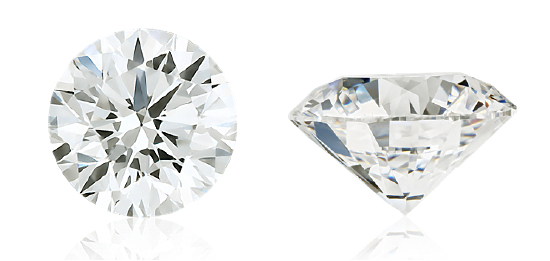Cut, Color, Clarity and Carat Weight
While many people have an understanding of different diamond cuts, there is more to ensuring you're buying a quality diamond. Cut, Color, Clarity and Carat weight, known as the 4C's, are the features that come together to determine the value of a diamond. These features also have a subtle effect on the unique beauty of your diamond. With an understanding of the 4C's you'll be ready to pick out your perfect diamond.
CUT
Of the 4C's, a diamond's cut has the greatest influence on its fire, sparkle and brilliance, making it, arguably, the most important C. Cut should not be mistaken for the shape of a diamond, but instead it assesses its proportions (how the diamond's angles and facets relate to one another), symmetry (the precision of the cut), and polish (the surface of the diamond).
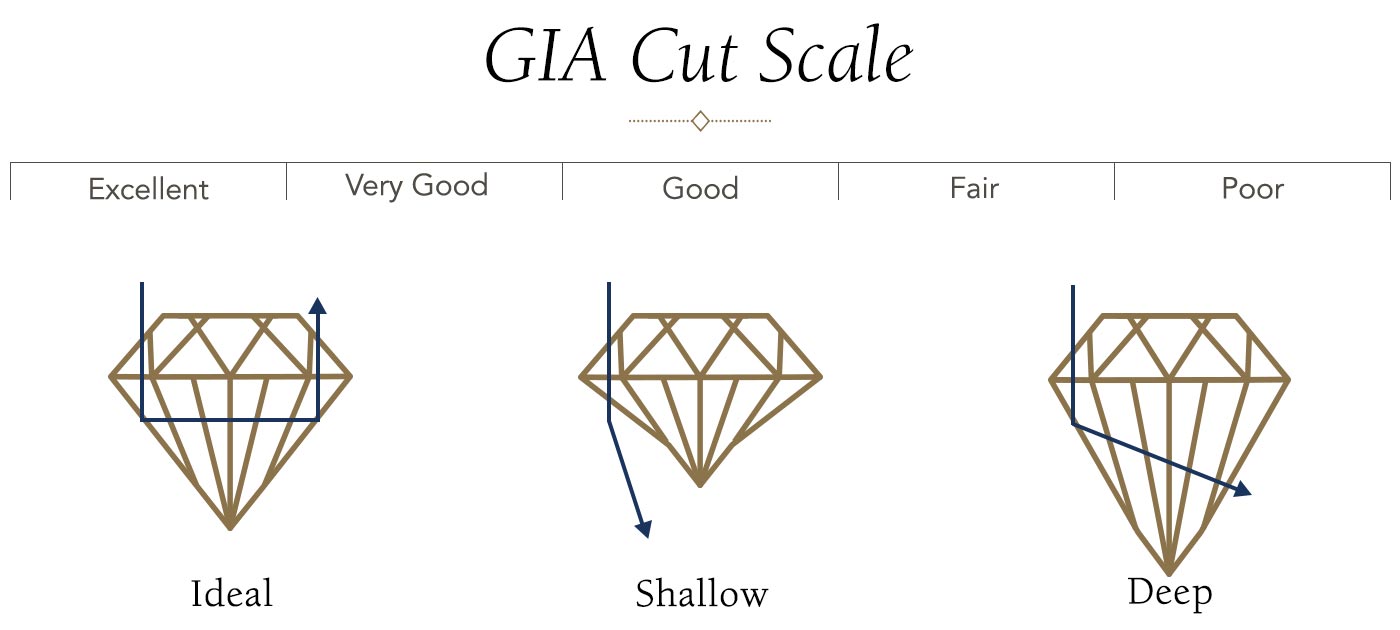
When a diamond is "Ideal-Cut," it means the angles and proportions of the diamond have been cut to produce the ultimate sparkle, fire and brilliance.
Brilliance: The intensity of the white light that is reflected from the diamond's surface and inside
Fire: How light scatters and disperses through the diamond to create a rainbow of light
Scintillation: Flashes of white light, or sparkles, that are visible when the diamond moves
COLOR
Fancy color diamonds aside, the best, most beautiful color for a diamond is no color at all. When it comes to color in a diamond, the less color you see, the better. Therefore, a diamond that is mostly colorless will have a greater value than one who has more hue. Although most diamonds are not completely white, it is best to try to get as close as possible to a stone that lacks the most color. The color of diamonds is classified by grading scales. A color grade of D is the highest, or the most transparent (colorless), while a grade of Z is the lowest, or the one with most color (light yellow or brown). Most of our diamonds are graded "near colorless" - between G and J on the color scale. At a J grade and beyond, the human eye can start to detect a yellow tint.
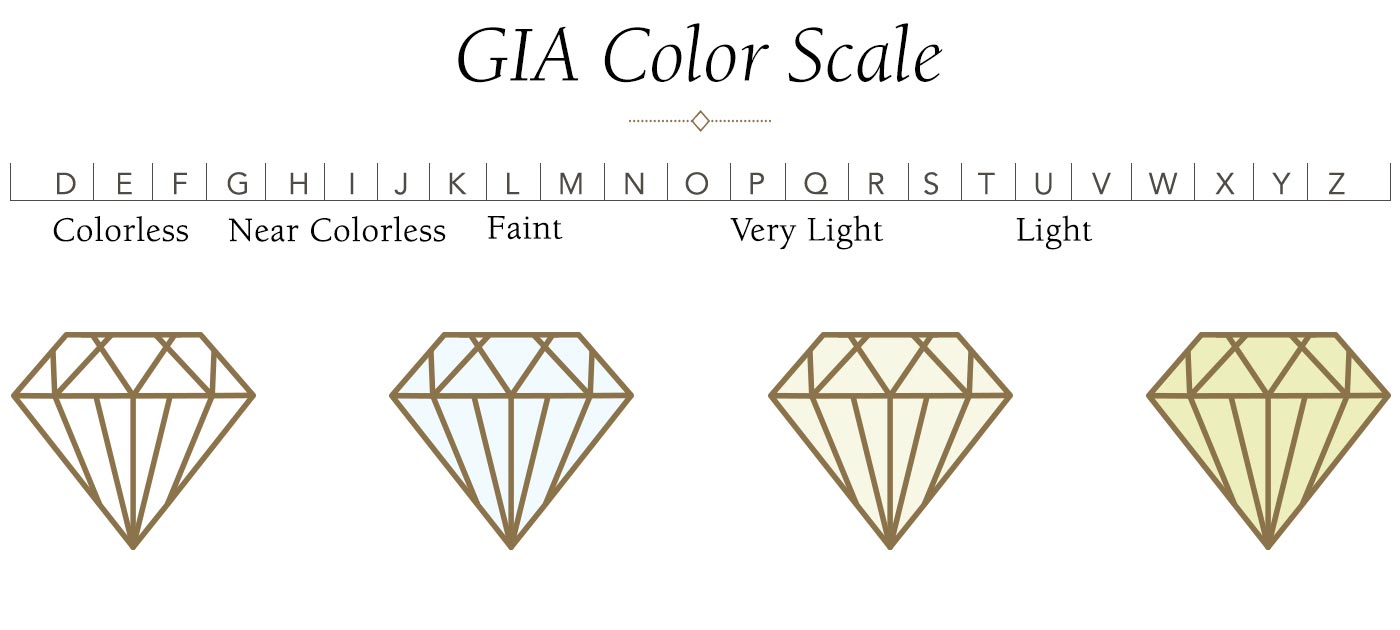
Tip: Diamond prices decline or increase in alphabetical order. For example, a diamond with a G or H color grade is less expensive than a diamond with a D color grade. Moving down the scale toward H or I lets you buy a diamond that still appears white, but is more common and more affordable.
D Color Diamond (Colorless)
H Color Diamond (Near Colorless)
CLARITY
Clarity is the degree to which a diamond is free from flaws, which can hinder light as it passes through your diamond. Like people, diamonds have "birthmarks" that vary in size, shape, position, quantity and color. These birthmarks are known as inclusions (internal) and blemishes (external). These characteristics are what give a natural diamond its character. The clarity grade is determined based on the size, number, position of, nature and color of the diamond's blemishes. A diamond with few imperfections will be more valuable and have a higher clarity grade. From all of the characteristics, clarity is the least important of the 4C's because the tiny imperfections are often microscopic and can't be seen with the naked eye.
Inclusions: Internal flaws formed deep in the earth during the diamond's growth
Blemishes: External flaws that can result from the cutting process
Remember, all diamonds are unique, not perfect. They are made underground through enormous pressure and heat. Natural inclusions and blemishes are inevitable.
Diamond Clarity Spans 6 Categories With A Total Of 11 Clarity Grades
I1, I2, I3 Included Diamonds- I clarity diamonds have obvious inclusions that are visible to a skilled grader using 10x magnification and may affect transparency and brilliance.
SI1, SI2 Slightly Included (SI) Diamonds
- Noticeable inclusions that range from easy (SI1) to very easy (SI2) to see are visible to a skilled grader using 10x magnification.
- Best value
VS1, VS2 Very Slightly Included (VS) Diamonds
- Minor inclusions ranging from difficult (VS1) to somewhat easy (VS2) to see are visible to a skilled grader using 10x magnification
- Great value
VVS1, VVS2 Very, Very Slightly Included (VVS) Diamonds
- VVS diamonds have minute inclusions that are difficult even for trained eyes to see under 10x magnification
- VVS clarity is rare and results in an eye clean appearance
Internally Flawless (IF) Diamonds
- No inclusions and only surface blemishes are visible to a skilled grader using 10x magnification.
- If diamonds have no inclusions within the stone, only surface characteristics set the grade
- Visually eye clean
Flawless (FL) Diamonds
- No inclusions and no blemishes visible to a skilled grader using 10x magnification.
- Less than 1% of all diamonds are FL clarity
- A flawless diamond is incredibly rare because it’s nearly impossible to find a diamond 100% free of inclusions
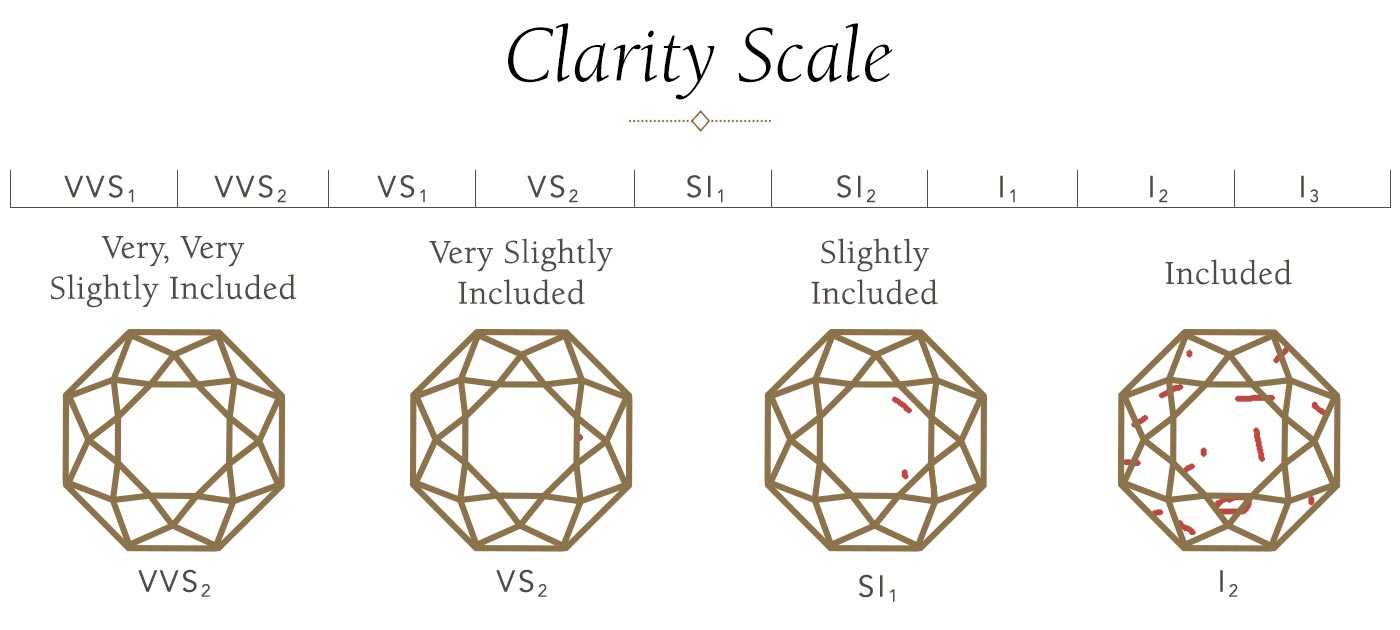
Tip: There are many misconceptions around the clarity of diamonds, including the belief that you need to buy a high clarity grade to avoid seeing imperfections. Another common falsehood is that a higher clarity grade results in more sparkle. Neither of these is true! Here are some tips to get you started on your diamond search:
- For the best value, select a diamond with inclusions that can’t be seen through the crown without magnification, like a diamond with an SI or VS clarity grade.
- While clarity is less important than a diamond’s cut or color, some diamond shapes require a higher clarity grade than others. Emerald and Asscher-shaped diamonds are designed with rectangular facets that emphasize transparency and let you see farther down into the diamond, which can make inclusions more visible. For these diamond shapes, choose a clarity grade of VS1 or better to ensure that the inclusions will not be visible. Conversely, Round, Princess, Oval, Marquise, Pear, and Heart-shaped diamonds may not require as high of a clarity grade. Cut with a brilliant facet pattern, which reflects light from many different angles, these shapes naturally hide many inclusions.
CARAT WEIGHT
The term carat actually refers to the diamond's total weight and not its size. Diamonds are weighed in units called carats. A carat is measured in increments called points. One carat is equal to 100 points. Two diamonds of equal weight can have very unequal value depending upon the cut, color and clarity of each. The misperception is that a larger carat weight is always better than a smaller carat weight. While it’s true that a big rock can be a status symbol, carat weight is not related to sparkle. Beautiful sparkle is the result of a well-crafted cut.

6 Things To Know About Carat Weight
- “Buy shy” to save money. Select a carat weight slightly below the whole and half-carat marks. For example, instead of a 2.00 carat diamond, consider buying a 1.90 carat weight. This will save a considerable amount of money, and the slight difference will never be noticed.
- Splurge on cut. This is the most important factor because it maximizes sparkle. In fact, a high carat weight diamond with a poor cut may look smaller than a diamond with a smaller carat weight and a very good cut.
- Keep ring size in mind. The smaller the finger, the larger the diamond will appear. A 1.50 carat diamond solitaire looks larger on a size 6 finger than a size 8.
- Certain settings can make a diamond appear larger. A very popular setting to achieve this effect is the halo. This setting has a ring of small diamonds around the center stone. The ratio of the small to large diamonds skews the perspective in your favor, making the center diamond seem larger.
- Band size affects the look of a diamond’s carat. Selecting a thin band creates a perspective that makes the center stone appear larger. A popular band to achieve this is the pavé, which features small diamonds embedded in the band.
- Carat Total Weight (CTTW). Total carat weight is the measurement of all the diamonds in any given piece combined. So, be sure to inquire about the weights of the individual diamonds in any piece that you are buying.


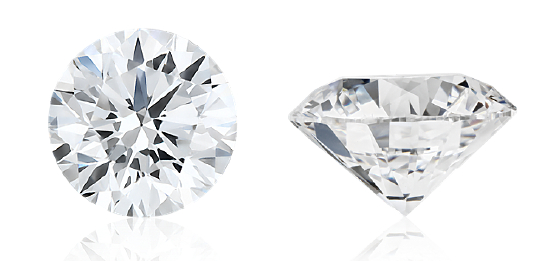 D Color Diamond (Colorless)
D Color Diamond (Colorless)